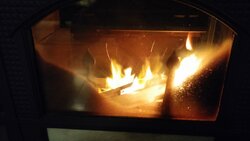New Keystone Install
- Thread starter Mryank9
- Start date
-
Active since 1995, Hearth.com is THE place on the internet for free information and advice about wood stoves, pellet stoves and other energy saving equipment.
We strive to provide opinions, articles, discussions and history related to Hearth Products and in a more general sense, energy issues.
We promote the EFFICIENT, RESPONSIBLE, CLEAN and SAFE use of all fuels, whether renewable or fossil.
You are using an out of date browser. It may not display this or other websites correctly.
You should upgrade or use an alternative browser.
You should upgrade or use an alternative browser.
- Status
- Not open for further replies.
Ashful
Minister of Fire
Woody Stover
Minister of Fire
It'll do that sometimes. I guess the heat of the cat ignites the smoke inside the screen. Probably a little early to say for sure, but any impressions on weather it's tossing more heat than the 2461? Mine definitely beats my 2460, but the Dutchwest comes a little closer when I have the blower running.Here's a pic showing the flame just inside of that cage
Definitely putting off the same I'd say even without the blower that I had on the DW. Loving it so far!
on an interior chimney unless you have 2" of clearance from the outside on the masonry structure to any combustible material the liner needs to be insulated. section R1001.15 of ircWhere does code call out a requirement for an insulated liner, @bholler? The majority of our forum must be out of code. Lol
here is a copy
http://www.rumford.com/code/clearances.html
Also unless the manufacture had it tested with the insulation for the zero clearance test and then payed for another test with out the insulation but with proper clearances. And i have never heard of one that did that. With out insulation it is not a listed product. And yes i can tell you that the majority of chimneys have at least one code violation if not many. but that doesn't mean that we shouldn't make it as good as possible.
Ashful
Minister of Fire
This was the case in my install, with an old single stone chimney, way out of code. So, we did the blanket wrapped liner for zero/zero clearance. However, according to all four installers who evaluated my chimneys, as well as the engineer at DuraVent, insulation would not be required if I were dropping the liner into any 20th century clay tile & masonry chimney.
Highbeam
Minister of Fire
This was the case in my install, with an old single stone chimney, way out of code. So, we did the blanket wrapped liner for zero/zero clearance. However, according to all four installers who evaluated my chimneys, as well as the engineer at DuraVent, insulation would not be required if I were dropping the liner into any 20th century clay tile & masonry chimney.
You're right Joful, if the chimney is legal and code compliant as a chimney then there is no requirement to insulate the liner. The insulation is to make up for a failed or out of compliance chimney. It is not required otherwise, however, it is desirable for other reasons.
I have to give the liner installer kudos for cleaning the crap out of the old fireplace so well.
That is bholler's point. It's not uncommon to find a masonry chimney that is out of code compliance. Many have <2" clearance from combustibles. The more retrofits and remodels the house has gone through, the more likely this clearance will get violated. Because we often can't look behind walls it's safer to assume the chimney is not code compliant. This 1970's chimney certainly wasn't compliant, but the problem was only discovered once pyrolysis took its toll some 40 yrs later.
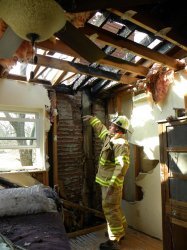

fire_man
Minister of Fire
Not true at all. Most modern chimneys i look at still no not have the required clearance to combustibles so our policy is that any liner we install gets insulated because it is a pretty safe bet that there is somewhere in the system where combustibles are to close. And it doesn't matter if it is clay lined or not with out the required clearance you need insulation to be code compliant.However, according to all four installers who evaluated my chimneys, as well as the engineer at DuraVent, insulation would not be required if I were dropping the liner into any 20th century clay tile & masonry chimney.
Last edited by a moderator:
Ashful
Minister of Fire
The three dominant causes of black glass:
1. Your wood may not be as dry as you think. 90% of dirty glass complaints are wet wood.
2. Burning very low in a catalytic stove, but you say you're running hot, so it ain't that.
3. If you have a door gasket leak, you'll sometimes get a partial staining of the glass. I honestly don't know why, as it's counter-intuitive that more air (= hotter fire) will cause dirty glass, but it's an oft-cited cause, nonetheless.
1. Your wood may not be as dry as you think. 90% of dirty glass complaints are wet wood.
2. Burning very low in a catalytic stove, but you say you're running hot, so it ain't that.
3. If you have a door gasket leak, you'll sometimes get a partial staining of the glass. I honestly don't know why, as it's counter-intuitive that more air (= hotter fire) will cause dirty glass, but it's an oft-cited cause, nonetheless.
Thanks for the reply..my wood has been about 13-18% moisture, probably on the higher end of that range. I wonder if I should tighten up the loading door, figured I didn't have to since it's a brand new stove but could be the gaskets settling from use
Woody Stover
Minister of Fire
I wouldn't think you should be seeing that much on the glass, the way you're burning. Check the glass gasket clips, might have to tighten them a little...don't overdo it. But like Joful said, probably just got into some damp wood.How normal is it for the glass to get blackened like this? I know it's only been a couple days of burning but I'm burning dry wood at hot temps
I think what happens is that the glass gets cooled, allowing creo to condense there.If you have a door gasket leak, you'll sometimes get a partial staining of the glass. I honestly don't know why, as it's counter-intuitive
Last edited:
So I wiped off the build up when the stove cooled to try and see if it'd come back and it did! Called Woodstock..they suggested checking the gap between the top of the glass and cast iron piece at the top that distributes the air, it was at 1/4" like they suggested. I did notice the inside glass gaskets seemed a little loose? Attached a few pictures to show you what I mean
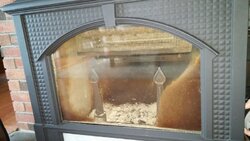
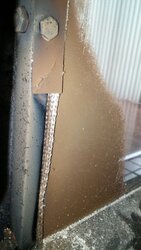
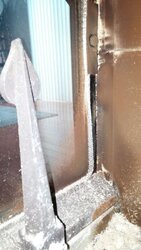



Last edited by a moderator:
Ashful
Minister of Fire
Not a woodstock owner / not sure what I'm looking at here, but that gasket appears to be on the wrong side of the glass! I suspect you should have the normal iron / gasket / glass / clamp arrangement of any other stove I've seen, but again, I don't know Woodstock.
Woody Stover
Minister of Fire
The glass gasket looks OK to me. The glass clips with the bolts hold the glass (padded by the rear part of the gasket) against the front of the gasket and in turn, the gasket against the stove front, and that's where the sealing takes place. It appears that your front vertical seam is leaking some air like mine is, as indicated by the creo being burned off at the seam. Mine was leaking from the start (I wasn't about to ship the stove back for this minor issue,) and I noticed the stove burning hotter on the left side. Looks like yours may be doing that as well, as indicated by less creo on the lower left glass. BTW, that is pretty much how my glass looks, maybe a little less in the corner, but I run a lot with no flame. Glass doesn't stay totally clean but I'm OK with it since the fire view is still fine, to me. Maybe when I fix the seam leak, more air will be drawn through the air wash, and the corners of the glass will stay cleaner. With mine, it finally got to the point where the stove top above the cat was going to 500 with the air cut all the way, so I pulled it and I'm running the Dutchwest until I decide weather I'm going to wait until summer to remove the front of the stove to re-cement, or weather I'll just re-seal the seam from the inside, put it back in, and run it for the rest of the season to see how it does. I just looked inside again, and a section of the cement has worked its way out of the seam. I may just take out the left glass clip, remove the cement from that entire seam, and re-cement. I'm thinking that if the cement was dry at the plant before they tightened the glass clip, maybe that is breaking the cement loose in that seam? Looking at the right vertical seam, there's no evidence of an air leak there. Wonder why this is only happening on the left side?
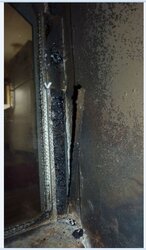

Thanks for the detailed response! It's frustrating to say the least considering I waited 6 months for the stove and it's only a little over a week in use. Hoping the good people at Woodstock can help me out further!
Woody Stover
Minister of Fire
Some types of wood just seem to haze my glass a little more. I've noticed that with Oak, but not sure if it just has a little more moisture, or if it's a characteristic of the Oak itself. There's no perfect stove, but I think you're gonna find the Keystone to be a lot closer than the 2461.Thanks for the detailed response! It's frustrating to say the least considering I waited 6 months for the stove and it's only a little over a week in use. Hoping the good people at Woodstock can help me out further!

fire_man
Minister of Fire
With mine, it finally got to the point where the stove top above the cat was going to 500 with the air cut all the way, so I pulled it and I'm running the Dutchwest
Woody - why do you believe a leaky seam would cause the stove top temp above the cat to "go to 500 with the air cut all the way"? These stoves still have air entry even when the damper is completely shut. There is an EPA hole in the ashpan housing for one example.
To confirm a leak, I would use a bic lighter and watch the flame get sucked into the suspicious leak while the stove was burning hard.
Woody Stover
Minister of Fire
When conditions were right in the firebox, the air coming in that seam would ignite smoke in the box, and flame would shoot out 4-5" along the entire length of the seam. Before the leak got that bad I could run the stove a lot slower, with a cooler stove top. When the leak got worse, couldn't cut the air enough to get a low burn. I have the Dutchwest in now but I'm going to put suction on the flue exit somehow, maybe a vacuum cleaner, and check all the seams. I don't see any evidence of other seams leaking, as indicated by the thin white line where the creo is burned off the stone in the above pics of mine and Mryank9.Woody - why do you believe a leaky seam would cause the stove top temp above the cat to "go to 500 with the air cut all the way"?
Sounds like you know this but that's two panes of glass so it's not likely there would be any leakage around both of those gaskets. That will also keep the inside glass hotter, and it should be less prone to gunk up than most other cat stoves. I don't know how well your stacks are protected but mine are just top-covered and even though the Cherry and soft Maple I have is dried 2 yrs, if rain blows on the sides of the stacks, the softer woods will re-absorb a little moisture. They can even bubble out the ends a little bit on a new load.I did notice the inside glass gaskets seemed a little loose?
fire_man
Minister of Fire
OK the 4-5" flame shooting at the seam convinces me of the leak. Usually those leaks can be fixed with the good quality WS furnace cement.
- Status
- Not open for further replies.
Similar threads
- Replies
- 1
- Views
- 298
- Replies
- 14
- Views
- 896
- Replies
- 5
- Views
- 916
- Replies
- 10
- Views
- 1K


